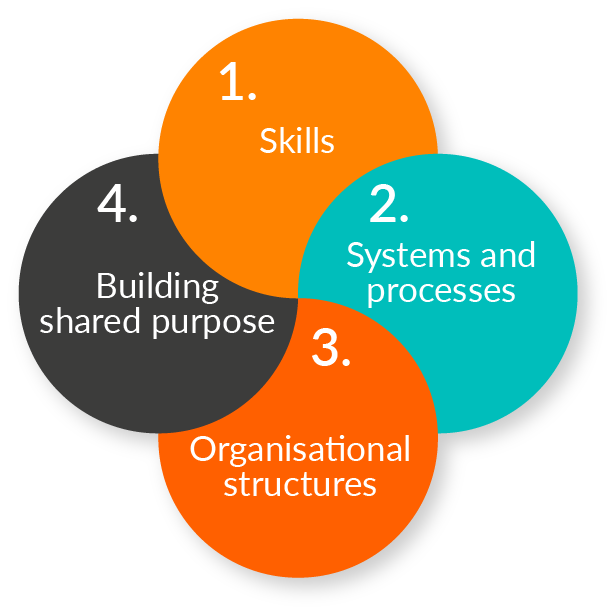In my previous blog about enterprise digitisation I concentrated on two main issues:
- How digitisation provides an opportunity to reconsider the limits of enterprise capability[1] and, possibly, to develop new execution skills.
- The importance of not getting distracted by the latest ‘shiny’ technology, and the need to focus more on business outcomes.
I was swapping thoughts with industry leaders and acquaintances from consulting organizations about the key challenges that are driving enterprise digitisation. After all, most of us have heard horror stories about failed initiatives; those that didn’t meet their stated objectives and that went significantly over budget and past deadline. This phenomenon is not limited to any particular country or industry sector – an entire body of research suggests that more than half of all such programs fail to meet their objectives.
It’s worth saying at the outset that almost every organisation finds change and adaptation a challenge. The longer and greater the institutional legacy the harder that process often feels. Indeed, how do we honour the memory of successes past while striding into the future? The good news is that it is possible.
Speaking with my circle, we came to the conclusion that to drive digitisation effectively, organisations would be well advised to focus on four key elements:
- Team composition should be reassessed to check it includes the necessary skills to adapt to the new environment.
- Ensure systems and processes are aligned to the new model (with greater agility and transparency) and around dashboards.
- Change the organisational structures to reflect the new paradigm and reduce hierarchy.
- Build empathy, community, and a sense of shared purpose and frame change as an opportunity rather than a threat.
Let’s look at each of these in more detail.

1. Skills
Inevitably, as the business environment evolves, enterprises find that they need to adjust. This doesn’t just demand a new set of skills, it requires the right mindset and a capacity for change.
We can see the same necessity throughout industrial history. As the industrial revolution gathered steam, mechanical power transformed cloth manufacturing from a cottage industry to factory-based mass production. This in turn led to the specialisation of labour. Demand arose for workers with new skills such as factory supervisors, fashion designers, sales-people and back office staff. The rate of change has, if anything gathered pace with a fast-evolving fashion industry focussed on predicting trends across market segments, and on agile manufacturing and logistics operations.
There’s always the risk that rapid change might leave employees overwhelmed by the constant need to adapt – as Lewis Carroll’s Alice was told: ‘We must run as fast as we can, just to stay in place. And if you wish to go anywhere you must run twice as fast as that.’
It’s almost a given that developing new skills requires us, both as individuals and as enterprises, to embrace new ways of thinking and working. I prefer to see it as much as an opportunity as a necessity.
- Individual curiosity is a great driver of personal growth, as is a willingness to push oneself outside one’s comfort zone.
- Organisations can support curiosity and experimentation through training and through creating an structured environment where safe experimentation is possible, efforts are optimised and objectives are clear.
- Enterprises also benefit from learning and developing new processes and structures to drive faster, more autonomous decision-making.

2. Systems and processes
In designing these, the idea is to prepare ourselves for a world in which we accept the inevitability and unpredictability of change. I suggest organisations aim for:
- Greater agility in decision making.
- Organisations often get caught in what’s been dubbed ‘analysis paralysis’ during periods of extreme disruption. Simplify decision making and aim for clarity on who has ‘decision rights’.
- The ability to manage ambiguity well in areas of uncertainty. This can be done through:
- Careful delineation of areas of risk, and defining of lead indicators and metrics.
- Running controlled experiments to test out approaches. As an example: a financial services provider was unsure how best to approach customers in order to cross-sell products. Options included a high-touch, agent-based approach and one skewed towards the use of digital assets such as chatbots and IVRs. To resolve the matter the firm listed possible concerns and defined assessment indicators including lead response rates and first-call resolution for issue closure. It ran controlled experiments to determine what would work best over a period of three months. Using the resulting data, the firm identified the optimal mix of customer segments and channels.
- Fresh thinking in plotting out the customer journey to ensure user needs are fully understood and prioritised and execution is smooth. A lender that we had partnered with had challenges with siloed thinking within its organisation that had left the overall process quite broken. Individual units (lead-gen, initial application, document gap closure, credit decision, and onboarding) were focused on being seen to meet their team SLAs, rather than on the organisation’s overarching goals. These require that the organization’s objectives are clearly defined, and likewise how these translate to the imperatives for each business function
3. Organisational structures
Sometimes we find that the organisational structures that served us well previously need to adapt to new sets of circumstances:
- A more fluid business world requires a faster flow of information and thus less hierarchy. Support to improve information flow across teams and drive innovation campaigns is often beneficial.
- Innovation is often at the intersection of domains – so organisations might do well to consider implementing a more matrixed structure with blurred boundaries between business functions and geographies. For example, customer acquisition might require product changes and multiple experiments in the channels. Likewise, customer support might prove a rich vein of inspiration for new products and improved product messaging.
- To drive change while retaining the core success DNA, it is important that the organisation has the readiness and capacity to bring in fresh talent able to work together with internal teams who understand context.
4. Building shared purpose
A willingness at the leadership level to define a broad strategic direction and understand new technologies, appreciate their impact while at the same time recognising the need for change is a huge asset.
As the consultants McKinsey have observed, the primary reason why change management programs fail to meet objectives is employee resistance and a lack of management support. Likewise, there is a 30% increase in success rate if teams are fully invested in change.

It can help significantly to identify relevant dashboards as a source of authoritative data that acts as a common reference, likewise metrics that can be a guidepost for the whole organisation.
Remember to communicate constantly about the key levers of change. It’s important to emphasise priorities to colleagues and, if relevant, underscore the urgency of the situation to drive action.
Summary
Each organisation’s situation is unique and the following should be calibrated accordingly:
- Speed of change – market changes, organisational readiness. I have seen situations. where employees have become really concerned because their leadership seems very tentative about changes.
- Priorities should be based on whether change needs to be at the customer end or within the organisation.
- Make full use of analytics and technology to ensure decisions are based on data so any course corrections are founded on evidence rather than intuition.
[1] Enterprise capability might encompass, just for the sake of example, an organisation’s speed of response, its ability to react to new analytics data about customer behaviour or to manage its supply chain better to achieve a price advantage.

